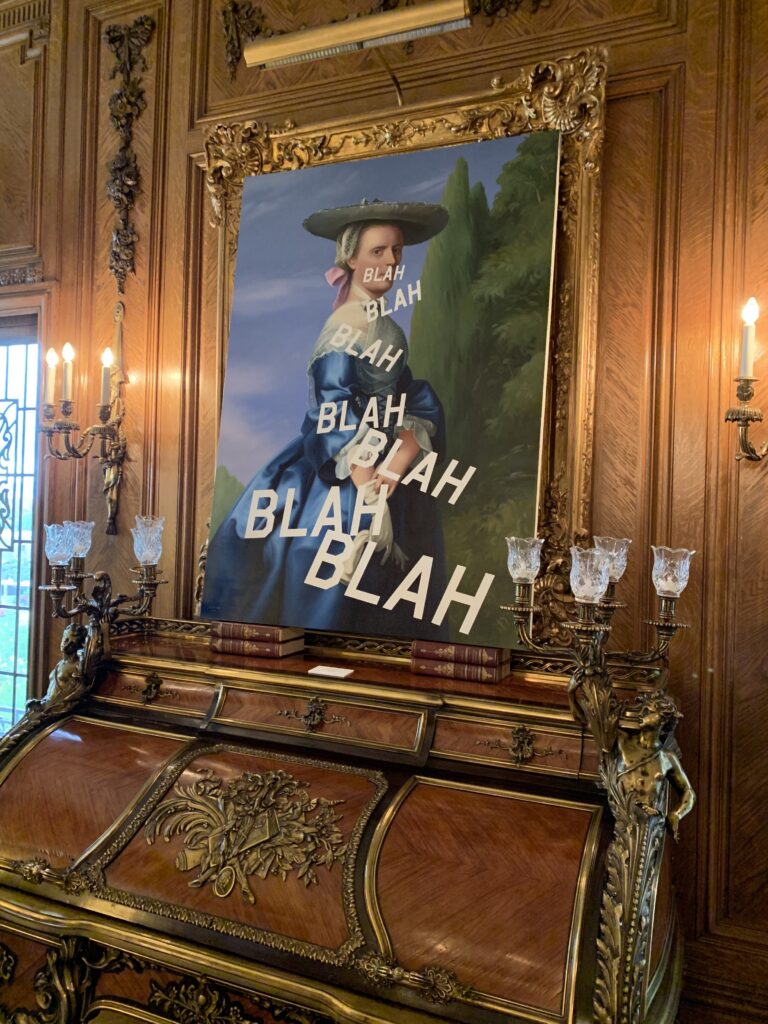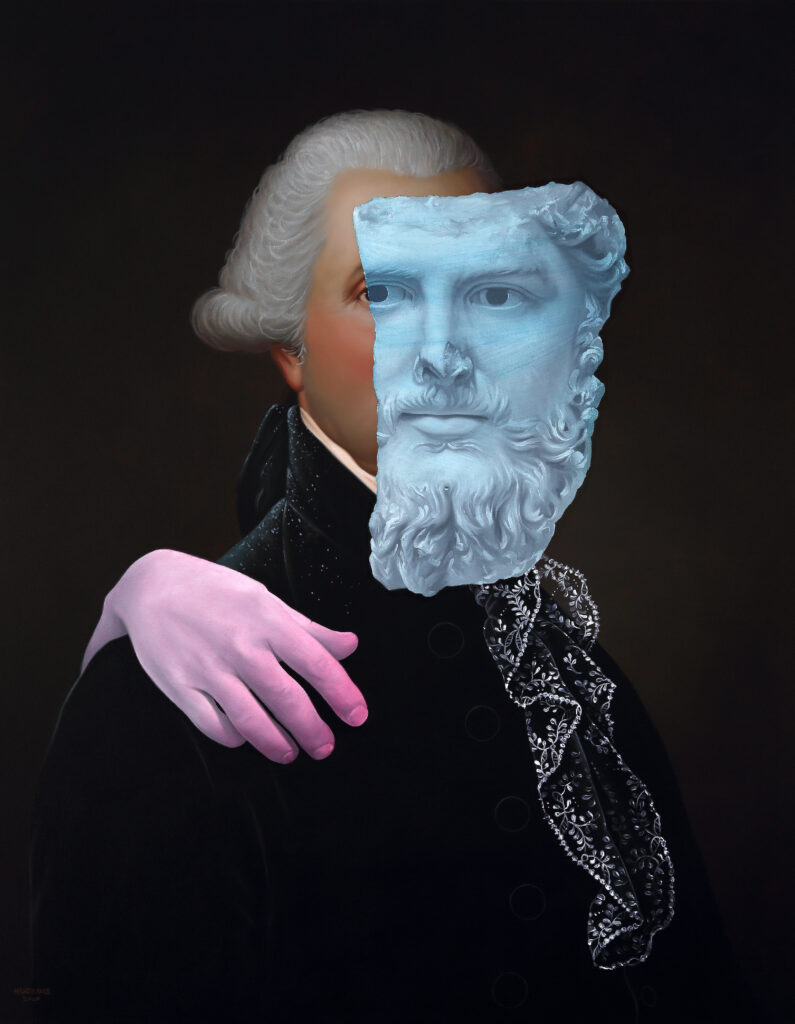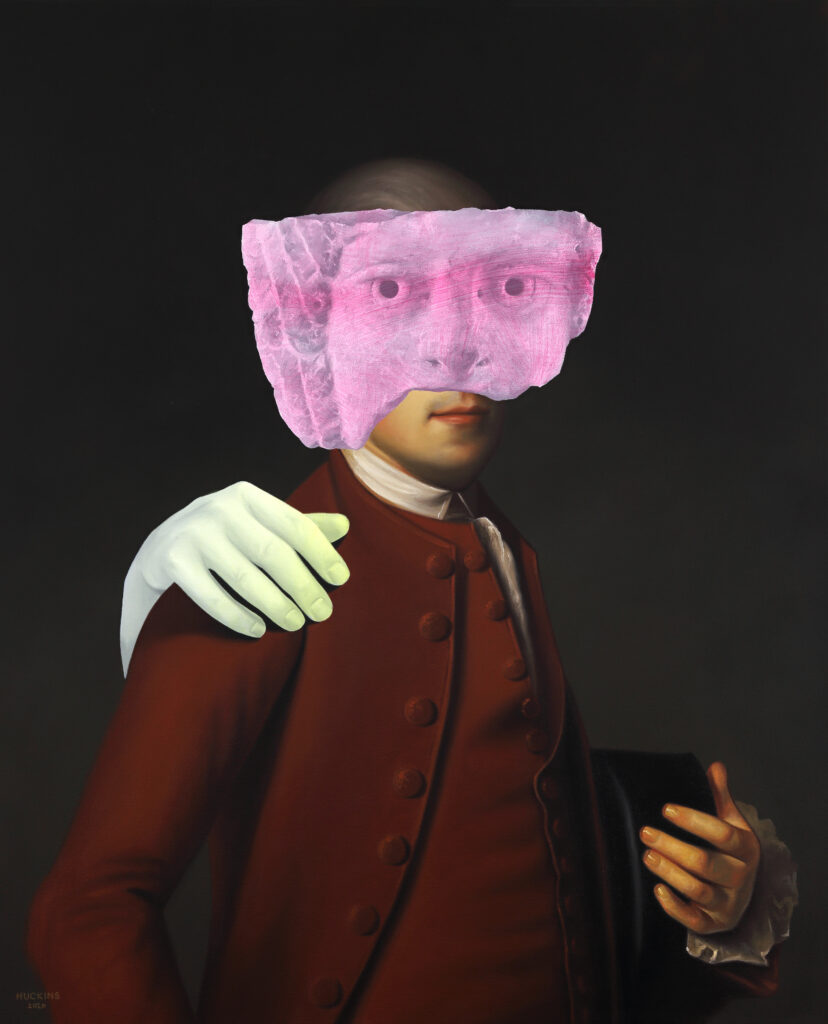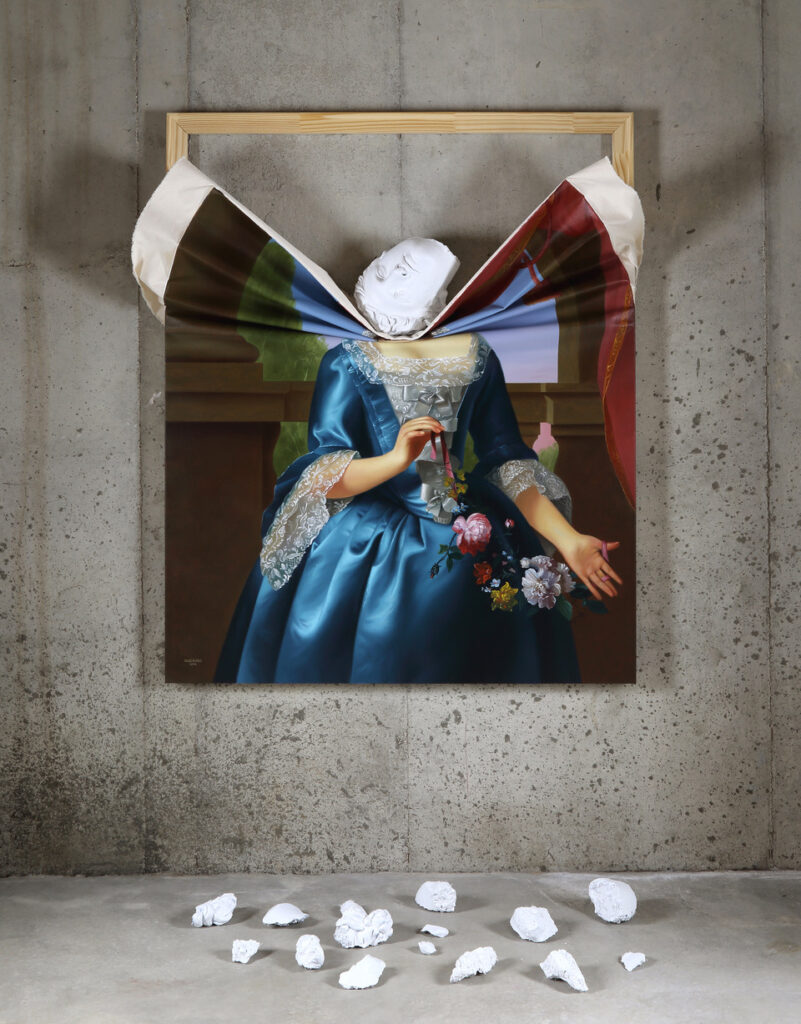
I recently interviewed Denver-based painter Shawn Huckins by email for a future article in Visual Art Source. More than the rudimentary questions and answers about process, materials and themes, though, the interview expanded into Huckins’ insightful comments on the current state of American society, including our overreliance on digital communication tools. The convenience of text messaging, Instagram, Twitter, Facebook and the like — and their effect on discourse and civility — are the inspiration for many of his paintings.
Be sure to have a look at Huckins’ work over the years on the webpages that I’ve linked below. The images prompt an immediate reaction to their sardonic humor, but it’s always followed by deeper thoughts about where society might be headed. The warp speed of digital communication, the possible devolution of language, the undeniable chaos in the White House, and the imperiled environment are among the many topics Huckins considers fair game.
Beyond the messaging, though, Huckins is a dedicated painter. He does not employ Photoshop or any kind of digital manipulation in creating his canvases. Every speck, every detail is hand-painted as he uncannily reproduces a neoclassical painting and then adds chunky lettering, squiggles, or other elements to suit the subject matter.

Get to know Huckins through this Q & A, and be sure to see his solo exhibition “Fool’s Errand” during its run at K Contemporary in Denver from June 6 to July 3, 2020. All photos are courtesy of Shawn Huckins and K Contemporary.
How much is your choice of subject matter driven by current events, and how much is driven by personal interests, for instance, your interest in history, your everyday encounters? Or are the two intertwined when you map out a certain series of work?
When I began the texting series (“The American Revolution Revolution”) about a decade ago, it was for my interest in American history. As a child, my favorite subject in school was history because I was already immersed in the traditions growing up in New England. Initially, the series began as a challenge from my cousin who said that I was a skilled painter, but could not paint portraits. To prove him wrong, I practiced portrait painting by replicating historic 18th-century American portraits. I was especially drawn to the portraits of John Singleton Copley as they were beautifully painted and were rendered in the same realistic style that I employed even before I started painting portraits.
One of the practice portraits ended up behind a tracing of the acronym ‘LOL’ drawn on it and I found that was an interesting contrast between the old and new. The painting came first and then the questions came later. For example, does how we communicate govern the value of what we communicate? At the beginning of this series, my text phrases were playful and a bit on the goofy side, to make light of how careless and mundane ‘digi-speak’ really was/is. As the years progressed, my text starting taking on more political tones, especially around the 2016 election and going forward. I never really paid attention to politics growing up and into my early adult life. The political race of 2016 changed my whole perspective and it started to reflect in my work. The phrases become political or derived from political sources when, in fact, they used to be apolitical.
In 2018, I created my ‘Erasures’ series, which is specifically political in nature. In this series, I recreated paintings within the White House Art Collection and ‘erased’ parts of the painting. The white- and gray-checkered pattern (which is all hand-painted) signifies when an image has been altered or erased in Photoshop. I wanted to show in a modern format that our history is being erased by a toxic government administration.
My latest body of work, titled ‘Fool’s Errand,’ focuses on our relationships with the past and how it affects our current state of the world and our place in it. Digging deep into what makes a society thrive, in addition to what makes a society collapse, ‘Fool’s Errand’ features a collection of paintings challenging the idea of learning from previous mistakes and what happens when those lessons go unfulfilled. Again, another politically driven series by constantly seeing a government making copious amounts of mistakes and creating lie after lie to cover up those mistakes. This series began with the statement first, then the imagery came after.

What’s the purpose behind the placement of slang/profane words and phrases, and words and phrases in general? Shock value? Something else? Are they perhaps a humorous point of entry into saying something more serious?
To be honest, at the very beginning of the series, I was not confident in my portrait making skills so I used the big, bold white lettering to obscure much of the face to hide any inaccuracies. For example, I would always try to cover one eye with a letter because if one eye is off, the entire face looks horrible. As I began to improve my skills, the text started shifting and becoming smaller to show more of the face. I’m still covering up the portrait, but it’s not as intrusive as it once was. But I also think ‘defacing’ the portrait with these phrases helps exaggerate the point that social media and the language that comes with it is a dominant force in today’s society and it’s hard to go a full day without interacting with some sort of techno-driven media — whether it’s Netflix, YouTube, Facebook, Instagram, etc. It’s such a huge part of our daily lives that I feel it has interrupted our one-on-one communication skills. It’s a sharp contrast to the civil, intelligible language used back in our country’s founding days.
Would you call your incorporation of social media culture (Twitter, texting, abbreviations, etc.) a parody on that culture, or just a reflection of it? I like your phrase “fragility of legacy” in the “Fool’s Gold” statement, and it leads me to believe you have serious concerns about our “insta-culture.” Could you comment on that?
It’s not really a parody, I see it more as a record or time-stamp. I feel as though I’m a documentary director in paint format and it’s my job to record the language used in social media. So while I’m not making fun of that language, one can easily see it as parody because the phrases that are riddled with misspellings and acronyms are already humorous in nature, especially contrasted with the powerful, historic portraits of America’s past.
In regards to ‘fragility of legacy,’ I believe it’s our nature as human beings to think about our impact on the world and how we want to be remembered. With social media, we try so hard to put our best face forward and only post the best images to show how happy and successful our lives are, while hiding the non-glamorous parts. It can cause depression to see your friends having a fantastic life while you’re struggling day to day, but most likely, your friends are in the same boat. They are hiding their insecurities like you. Everyone is so fragile and wants to be remembered for only positive things, but life has challenging parts too. And I think it’s bold and honest to share those parts of your life as well, to really engage in the human experience.
How do you go about selecting the classic works of art that tie together a series?
I choose my subjects based on what I’m initially drawn to. I tend to lean toward paintings that have a realistic style. For example, 18th-century portraits by John Singleton Copley are incredibly well painted, and offer a challenging experience when I create my own painting. I also look at portraits as if they tell stories, so if the portrait is unique (either because of the environment the subject is placed in, their clothing, or the expression on their face), I will likely choose that element to engage with the digital text phrases. Additionally, to tie an exhibition together, I will select paintings that are cohesive and share a common trait. For example, for my first international solo in France last October, the entire show consisted of French artists that I replicated. Furthermore, in my series ‘American Revolution Revolution’ all of the works are from 18th-century American painting, while the series ‘The American __tier’ consists of works from 19th-century American painting.
Among the artists I connect with are Gilbert Stuart, Rembrandt Peale, George Caleb Bingham, to name a few.
Is the act of painting a classic work to replicate it a vital part of your process?
My main source while I’m painting is a digital photo of the painting. Most museum websites offer public domain high-res images for free download. I have a computer screen right next to my canvas and palette, so I’m viewing the high-res image on the computer screen while painting. I’ve been painting this way for at least a decade.
I try to replicate the painting pretty close to the original to make the statement of contrasting the old with the new and how we may be losing sight of the values once held centuries ago. It’s easy to idolize centuries past as being more civil and intelligible because technology was not the driving force as seen today. With my latest work under ‘Fool’s Errand,’ I’m taking more liberties and manipulated the paintings even more so, or changing the background completely to signify our current day manipulations of the past.
So “Fool’s Errand” is a commentary on the deep contrasts between today’s society and the time of our Founding Fathers? Is that a reasonable interpretation, and could you articulate your decision to use the disembodied hands and Roman sculpture?
That is a great interpretation and it focuses on our evolution as a society and learning from past historical mistakes. For the last three years, my work has been politically driven. I have become obsessed with how politics work and doesn’t work in the country and I’m finding that my work is becoming easier to create because I’m so driven with saying ‘something’ about the current political climate. I feel it’s an artist’s job to observe the world they live in and record what they see and to be honest with those feelings. In ‘Fool’s Errand,’ I’m seeing a government that is so obsessed with ratings and looking good, that they will lie and make gross misjudgments to come across as being ‘pro-America’ when all it is, is fake patriotism. To be a successful society, you have to learn from previous mistakes and evolve.
The COVID-19 pandemic is a great example of how not to manage a crisis. It could have been far less severe if we had followed the proper precautions and learned from past outbreaks. I use Roman sculpture to signify a thriving society that once flourished, but has become extinct. Is America immune to destruction and extinction? Could we end up a failed society, just like the Romans did? I use the ‘paranormal’ hands to signify the ghosts of the future and to show how our current government is manipulating the past — a past that wasn’t perfect, but has been evolving for the general good. It seems now, we are going back in history and undoing the hard work of generations past, all for ego and spite. For example, our exit from the Paris Climate Accord to name one undoing.
‘Fool’s Errand’ will have a installation-type piece. It basically consists of a reproduced portrait with a concrete sculptural head weighing down the top portion of the canvas. It’s sort of a fall-from-grace installation. Fragments of the concrete head are lying on the floor beneath the painting.

What else is on tap for you professionally in 2020?
My next show after June’s K Contemporary show is a solo at Stephanie Chefas Projects in Portland, OR in October. Soon after, I’ll have a solo at Modernism in San Francisco in November. Busy busy!